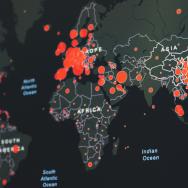Even before the coronavirus pandemic, communities around the world grappled with growing inequality, automation of jobs, and dependence on global markets. While COVID-19 widened many of those gaps and continues to plague parts of the globe, Prof. Raghuram Rajan remains optimistic about one opportunity: deciding how to rebuild.
To do that, we start by empowering local communities—the same ones that stepped up during the pandemic, said Rajan, the Katherine Dusak Miller Distinguished Service Professor of Finance at the University of Chicago Booth School of Business.
Rajan shared insights from his research and his book, The Third Pillar: How Markets and the State Leave the Community Behind, during a virtual event hosted by the Hong Kong Jockey Club Programme on Social Innovation.
The event also offered local insights for strengthening communities in Hong Kong. Rajan reflected on these issues in a conversation with Leong Cheung, executive director of charities and community at the Hong Kong Jockey Club. The event was moderated by Randall S. Kroszner, the Norman R. Bobins Professor of Economics and the deputy dean for executive programs at Chicago Booth.
Below are four takeaways from the research and discussion.
Reversing the loss
While the internet and communication technology revolution devastated many rural and middle class communities in the West by moving manufacturing jobs abroad, Rajan said the globalization of governance also did its part.
Communities lost much of their power to national and international agencies, as “the powers to decide have migrated up and up because markets are global,” Rajan said. Whether it’s capital requirements at a bank or European Union business regulations, decisions which were once set locally are now set at an international level.
COVID-19, however, showed that international or national power is not always enough to solve every crisis and, in some cases, can even exacerbate problems. Both Rajan and Cheung said local communities filled a critical role during the pandemic, from delivering food and medical supplies to elderly or disabled, accompanying them to their doctor’s appointments, or updating ventilation systems in care homes.
Decentralizing power
“We need to pull back power from the international to local,” Rajan said, calling for a decentralization of power. “Not every power can, or ought to, be pulled back. You don’t determine international emission agreements at a local level, but there’s a lot that can be pulled back.”
While this might involve returning power to communities to decide issues like primary education policies, it also has an important economic implication. By spreading economic activity beyond centralized urban areas, the pandemic showed the possibilities of remote work on an international scale.
“Today, good jobs can be done from home in businesses far away,” Rajan said. “Thirty-seven percent of jobs, my Booth colleagues have established, in rich countries can be done from home. You can be sitting in a remote place while doing a job in New York City. We need more of that to spread economic activity.” The return of professionals and knowledge workers to areas which once only saw an exodus of its best and brightest offers a huge economic and social potential.
Viewing technology as a helpful tool
Where access to technology once removed economic and political power from the community, it can now play a critical role returning that power by connecting workplaces around the world. In addition to hosting offsite work, which cuts down on commutes and infuses dollars saved into the local community, technology can connect local markets to the global economy.
“We now have the technology to revive communities,” Rajan said. “We need to push decision making down to them to allow them to decide what makes sense to them for the kind of economic investments locally.”
But where to start? Rajan said countries like Canada offer a good example of how to incorporate local viewpoints into decision making. A key first step is to start government or private funding of a few groups, and through trial and error deciding where to expand, incorporating the viewpoints of community leaders and stakeholders, he said.
Cheung said this concern is also at the heart of Jockey Club operations: “The spirit of empowerment in the community is very important. The question we always have is empowerment is a big word—how do we find the right tools to actively listen to those voices or find the right voices to directly empower the community?”
The Hong Kong approach
In the early days of the pandemic, the Hong Kong Jockey Club mobilized to help but was faced with the kind of dilemma Rajan described—delegating power to the community while ensuring funds went to the right place. “You cannot decide everything in a very centralized fashion especially during a crisis,” Cheung said.
Instead, they turned to the experts—local community groups—and through a combination of surveys, data, and active listening, they were able to provide 100 million Hong Kong dollars ($12.88 million US) in assistance to 220 different groups. Cheung said technology played a critical role helping communities streamline operations, collect better data, and improve lives. Connecting elderly care home residents with Zoom technology, for example, allowed them to do video calls with relatives.
“We very seldom think of technology as to generate or maximize the benefits to a lot more stakeholders,” Cheung said, “but sometimes (if we take) some of these commercially viable technologies, if we spread the talent and effort and apply them to social groups, I think it goes a long way.”
—A version of this story was first published by the Rustandy Center for Social Sector Innovation, which operates the Hong Kong Jockey Club Programme on Social Innovation.

